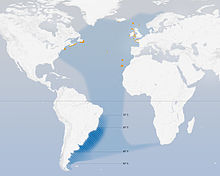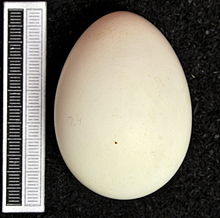
The tufted puffin, also known as crested puffin, is a relatively abundant medium-sized pelagic seabird in the auk family (Alcidae) found throughout the North Pacific Ocean. It is one of three species of puffin that make up the genus Fratercula and is easily recognizable by its thick red bill and yellow tufts.

Procellariiformes is an order of seabirds that comprises four families: the albatrosses, the petrels and shearwaters, and two families of storm petrels. Formerly called Tubinares and still called tubenoses in English, procellariiforms are often referred to collectively as the petrels, a term that has been applied to all members of the order, or more commonly all the families except the albatrosses. They are almost exclusively pelagic, and have a cosmopolitan distribution across the world's oceans, with the highest diversity being around New Zealand.

Puffins are any of three species of small alcids (auks) in the bird genus Fratercula. These are pelagic seabirds that feed primarily by diving in the water. They breed in large colonies on coastal cliffs or offshore islands, nesting in crevices among rocks or in burrows in the soil. Two species, the tufted puffin and horned puffin, are found in the North Pacific Ocean, while the Atlantic puffin is found in the North Atlantic Ocean.

Seabirds are birds that are adapted to life within the marine environment. While seabirds vary greatly in lifestyle, behaviour and physiology, they often exhibit striking convergent evolution, as the same environmental problems and feeding niches have resulted in similar adaptations. The first seabirds evolved in the Cretaceous period, and modern seabird families emerged in the Paleogene.
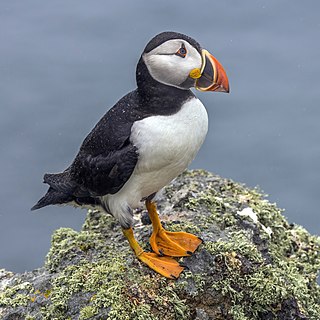
The Atlantic puffin, also known as the common puffin, is a species of seabird in the auk family. It is the only puffin native to the Atlantic Ocean; two related species, the tufted puffin and the horned puffin are found in the northeastern Pacific. The Atlantic puffin breeds in Russia, Iceland, Ireland, Norway, Greenland, Newfoundland and Labrador, Nova Scotia, and the Faroe Islands, and as far south as Maine in the west and France in the east. It is most commonly found in the Westman Islands, Iceland. Although it has a large population and a wide range, the species has declined rapidly, at least in parts of its range, resulting in it being rated as vulnerable by the IUCN. On land, it has the typical upright stance of an auk. At sea, it swims on the surface and feeds on zooplankton, small fish, and crabs, which it catches by diving underwater, using its wings for propulsion.

Shearwaters are medium-sized long-winged seabirds in the petrel family Procellariidae. They have a global marine distribution, but are most common in temperate and cold waters, and are pelagic outside the breeding season.

The family Procellariidae is a group of seabirds that comprises the fulmarine petrels, the gadfly petrels, the diving petrels, the prions, and the shearwaters. This family is part of the bird order Procellariiformes, which also includes the albatrosses and the storm petrels.
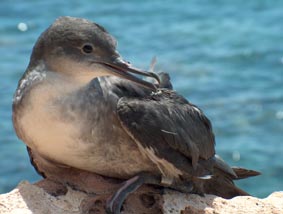
The Balearic shearwater is a medium-sized shearwater in the seabird family Procellariidae. Puffinus is a Neo-Latin loanword based on the English "puffin" and its variants, that referred to the cured carcass of the fat nestling of the Manx shearwater, a former delicacy. The specific mauretanicus refers to Mauretania, an old name for an area of North Africa roughly corresponding to Morocco and Algeria. The Balearic Shearwater is listed critically endangered by the IUCN and is one of Europe’s most endangered seabirds.

The little shearwater is a small shearwater in the petrel family Procellariidae. Despite the generic name, it is unrelated to the puffins, which are auks, the only similarity being that they are both burrow-nesting seabirds.

Skomer or Skomer Island is an island off the coast of Pembrokeshire, in the community of Marloes and St Brides in west Wales. It is well known for its wildlife: around half the world's population of Manx shearwaters nest on the island, the Atlantic puffin colony is the largest in southern Britain, and the Skomer vole is unique to the island. Skomer is a national nature reserve, a Site of Special Scientific Interest and a Special Protection Area. It is surrounded by a marine nature reserve and is managed by the Wildlife Trust of South and West Wales.

The yelkouan shearwater, Levantine shearwater or Mediterranean shearwater is a medium-sized shearwater in the seabird family Procellariidae. It was formerly treated as a subspecies of the Manx shearwater.
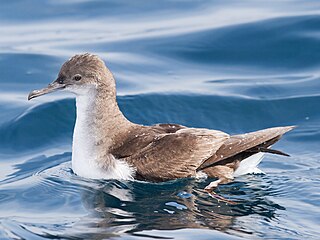
Puffinus is a genus of seabirds in the order Procellariiformes that contains about 20 small to medium-sized shearwaters. Two other shearwater genera are named: Calonectris, which comprises three or four large shearwaters, and Ardenna with another seven species.

The wedge-tailed shearwater is a medium-large shearwater in the seabird family Procellariidae. It is one of the shearwater species that is sometimes referred to as a muttonbird, like the sooty shearwater of New Zealand and the short-tailed shearwater of Australia. It is found throughout the tropical Pacific and Indian Oceans, roughly between latitudes 35°N and 35°S. It breeds on the islands off Japan, on the Islas Revillagigedo, the Hawaiian Islands, the Seychelles, the Northern Mariana Islands, and off Eastern and Western Australia.

The flesh-footed shearwater is a medium-sized shearwater. Its plumage is black. It has pale pinkish feet, and a pale bill with a distinct black tip. Together with the equally light-billed pink-footed shearwater, it forms the Hemipuffinus group, a superspecies which may or may not have an Atlantic relative in the great shearwater. These large shearwaters are among those that have been separated into the genus Ardenna. Recent genetic analysis indicates evidence of strong divergence between Pacific colonies relative to those in South and Western Australia, thought to be explained by philopatry and differences in foraging strategies during the breeding season.

Muttonbirding is the seasonal harvesting of the chicks of petrels, especially shearwater species, for food, oil and feathers by recreational or commercial hunters. Such hunting of petrels and other seabirds has occurred in various locations since prehistoric times, and there is evidence that many island populations have become extinct as a result. More recently ‘muttonbirding’ usually refers to the regulated and sustainable harvesting of shearwaters in Australia and New Zealand. These include the short-tailed shearwater, also known as the yolla or Australian muttonbird, in Bass Strait, Tasmania, as well as the sooty shearwater, also known as the titi or New Zealand muttonbird, on several small islands known as the Muttonbird Islands, scattered around Stewart Island in the far south of New Zealand.

The Bonin petrel or nunulu is a seabird in the family Procellariidae. It is a small gadfly petrel that is found in the northwest Pacific Ocean. Its secretive habits, remote breeding colonies and limited range have resulted in few studies and many aspects of the species' biology are poorly known.

The fluttering shearwater is a species of seabird in the family Procellariidae. It is endemic to New Zealand and migrates to Australia and the Solomon Islands. Its natural habitats are open seas and rocky shores. It has been known as Forster's shearwater in the past.
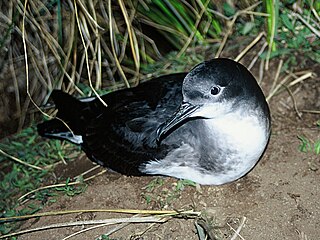
Hutton's shearwater is a medium-sized ocean-going seabird in the family Procellariidae. Its range is Australian and New Zealand waters, but it breeds only in mainland New Zealand. Its conservation status is Endangered, because there are just two remaining breeding colonies, located in the Seaward Kaikōura Range. Six other shearwater colonies have been wiped out by introduced pigs. Hutton's shearwater is the only seabird in the world that is known to breed in alpine areas. Conservation measures for the bird include community initiatives to rescue birds that crash-land at night on streets in Kaikōura, and the establishment of a protected area on the Kaikōura Peninsula including a predator-proof fence, man-made burrows, and translocating fledglings from the remaining colonies.

Austral storm petrels, or southern storm petrels, are seabirds in the family Oceanitidae, part of the order Procellariiformes. These smallest of seabirds feed on planktonic crustaceans and small fish picked from the surface, typically while hovering. Their flight is fluttering and sometimes bat-like.

The term seabird is used for many families of birds in several orders that spend the majority of their lives at sea. Seabirds make up some, if not all, of the families in the following orders: Procellariiformes, Sphenisciformes, Pelecaniformes, and Charadriiformes. Many seabirds remain at sea for several consecutive years at a time, without ever seeing land. Breeding is the central purpose for seabirds to visit land. The breeding period is usually extremely protracted in many seabirds and may last over a year in some of the larger albatrosses; this is in stark contrast with passerine birds. Seabirds nest in single or mixed-species colonies of varying densities, mainly on offshore islands devoid of terrestrial predators. However, seabirds exhibit many unusual breeding behaviors during all stages of the reproductive cycle that are not extensively reported outside of the primary scientific literature.

